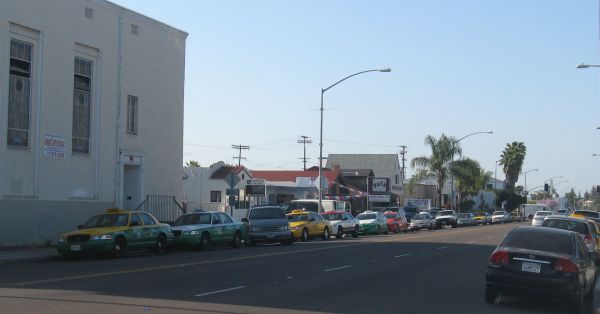Shoemaker Huajian says new $2bn manufacturing zone will transfer skills to locals so they can become the future managers
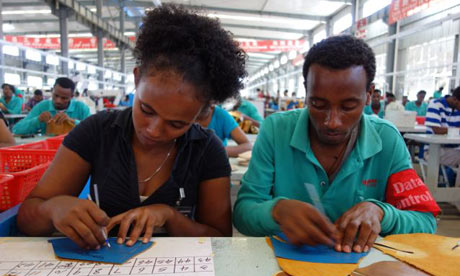
Ethiopian workers at
Huajian's shoe factory near Addis Ababa mark out leather for shoes.
Photograph: Elissa Jobson/guardian.co.uk
Helen Hai, vice-president of Chinese footwear manufacturer the Huajian Group, has a bold ambition. Within a decade, she wants Ethiopia to be a global hub for the shoe industry, supplying the African, European and American markets.
"We are not coming all the way here just to reduce our costs by 10 to 20%," Hai says. "Our aim is in 10 years' time to have a new cluster of shoe making here. We want to build a whole supply chain … I want everything to be produced here."
Huajian has a factory near Addis Ababa employing 600 people, which opened in January 2012, and has committed to jointly invest $2bn (£1.3bn) over the next decade to create a light manufacturing special economic zone in Ethiopia, creating employment for around 100,000 Ethiopians. The company, which employs 25,000 workers in China, expects to be able to provide around 30,000 jobs in Addis Ababa by 2022.
Huajian's partner in this project is the China-Africa Development Fund (CADFund), a private equity facility promoting Chinese investment in the continent. Born out of the 2006 Forum on China-Africa Co-operation, the fund was launched in June 2007 with $1bn provided by the China Development Bank. A further injection of $2bn was made early last year.
CADFund focuses on funding agriculture, infrastructure, natural resources and industrial park projects like that planned by Huajian, and has invested in a diverse range of ventures including a power plant in Ghana, a port in Nigeria, cotton farms in Malawi and a $100m car plant in South Africa.
Hai's vision is on its way to becoming a reality: a lease has been signed on 300 hectares (741 acres) of land in Lebu, on the outskirts of Addis Ababa, where Huajian plans to build a "shoe city", providing accommodation for up to 200,000 workers and factory space for other producers of footwear, handbags and accessories. The complex will offer help and advice to entrepreneurs setting up companies. "[It will be] a one-stop shop for manufacturers that are similar to us," Hai, who expects construction on the site to begin this year, says.
"One thing in my strategy is very clear: that I don't want to compete with locals," Hai says. "I want to help them grow because when local producers grow, the whole market is growing. If it is just myself growing here in five years' time, I will leave."
 A pair of Huajian shoes ready to be boxed up for export. Photograph: Elissa Jobson/guardian.co.uk
One area where she feels the company could make a difference is in
leather tanning. "The sheepskin and goatskin are good but local people
don't know how to manage cowskin," Hai says. "I want to offer my skills
to help the locals. I don't want to have my own tannery because I don't
want to create problems. I want to be friendly."
A pair of Huajian shoes ready to be boxed up for export. Photograph: Elissa Jobson/guardian.co.uk
One area where she feels the company could make a difference is in
leather tanning. "The sheepskin and goatskin are good but local people
don't know how to manage cowskin," Hai says. "I want to offer my skills
to help the locals. I don't want to have my own tannery because I don't
want to create problems. I want to be friendly."
This kind of warm and fuzzy talk from a Chinese company may surprise some analysts, academics and journalists who often characterise China's involvement in Africa as voracious neocolonial pillaging. Hai admits that her strategy is not necessarily pursued by every Chinese private enterprise operating in the continent.
Zemedeneh Negatu, managing partner at Ernst & Young Ethiopia, welcomes Huajian's plan to build a complete supply chain for the shoe industry and applauds its efforts to transfer skills. "That should be the goal. You create clusters around one or two major foreign or Ethiopian investors, throughout the country, based on competitive and comparative advantages," he says. "Huajian could be the anchor but all around are Ethiopian companies. It should be made clear to investors that they need to help build local capacity."
The company cites employee welfare as a priority. In China, Huajian has a modest outfit 40km (25 miles) south of the capital, Beijing, employing 1,700 workers and exporting more than $1m worth of shoes each month to the US and the UK. In Dongguan, in the southern province of Guangdong, the majority of the staff come from poor rural areas. The company provides accommodation, hot meals, clothing and laundry services, as well as free childcare. A similar package is offered to its Ethiopian workers who, in addition, earn 10% above the average local wage.
The Huajian factory near Addis Ababa employs 130 Chinese workers, all in supervisory roles. The number of expatriates on the payroll has come down from 200 when production began in January 2012, and Huajian plans to reduce it further. "For me, localisation is so important. I don't see myself managing this factory in five to eight years' time. I see someone local standing here talking to you," Hai says.
The company has selected 130 university graduates from southern Ethiopia to spend a year in China at its training facility. About 270 more will be recruited later. "They are going to be the future managers," Hai says. "They are going to be a new force."
"We are not coming all the way here just to reduce our costs by 10 to 20%," Hai says. "Our aim is in 10 years' time to have a new cluster of shoe making here. We want to build a whole supply chain … I want everything to be produced here."
Huajian has a factory near Addis Ababa employing 600 people, which opened in January 2012, and has committed to jointly invest $2bn (£1.3bn) over the next decade to create a light manufacturing special economic zone in Ethiopia, creating employment for around 100,000 Ethiopians. The company, which employs 25,000 workers in China, expects to be able to provide around 30,000 jobs in Addis Ababa by 2022.
Huajian's partner in this project is the China-Africa Development Fund (CADFund), a private equity facility promoting Chinese investment in the continent. Born out of the 2006 Forum on China-Africa Co-operation, the fund was launched in June 2007 with $1bn provided by the China Development Bank. A further injection of $2bn was made early last year.
CADFund focuses on funding agriculture, infrastructure, natural resources and industrial park projects like that planned by Huajian, and has invested in a diverse range of ventures including a power plant in Ghana, a port in Nigeria, cotton farms in Malawi and a $100m car plant in South Africa.
Hai's vision is on its way to becoming a reality: a lease has been signed on 300 hectares (741 acres) of land in Lebu, on the outskirts of Addis Ababa, where Huajian plans to build a "shoe city", providing accommodation for up to 200,000 workers and factory space for other producers of footwear, handbags and accessories. The complex will offer help and advice to entrepreneurs setting up companies. "[It will be] a one-stop shop for manufacturers that are similar to us," Hai, who expects construction on the site to begin this year, says.
"One thing in my strategy is very clear: that I don't want to compete with locals," Hai says. "I want to help them grow because when local producers grow, the whole market is growing. If it is just myself growing here in five years' time, I will leave."
 A pair of Huajian shoes ready to be boxed up for export. Photograph: Elissa Jobson/guardian.co.uk
One area where she feels the company could make a difference is in
leather tanning. "The sheepskin and goatskin are good but local people
don't know how to manage cowskin," Hai says. "I want to offer my skills
to help the locals. I don't want to have my own tannery because I don't
want to create problems. I want to be friendly."
A pair of Huajian shoes ready to be boxed up for export. Photograph: Elissa Jobson/guardian.co.uk
One area where she feels the company could make a difference is in
leather tanning. "The sheepskin and goatskin are good but local people
don't know how to manage cowskin," Hai says. "I want to offer my skills
to help the locals. I don't want to have my own tannery because I don't
want to create problems. I want to be friendly."This kind of warm and fuzzy talk from a Chinese company may surprise some analysts, academics and journalists who often characterise China's involvement in Africa as voracious neocolonial pillaging. Hai admits that her strategy is not necessarily pursued by every Chinese private enterprise operating in the continent.
Zemedeneh Negatu, managing partner at Ernst & Young Ethiopia, welcomes Huajian's plan to build a complete supply chain for the shoe industry and applauds its efforts to transfer skills. "That should be the goal. You create clusters around one or two major foreign or Ethiopian investors, throughout the country, based on competitive and comparative advantages," he says. "Huajian could be the anchor but all around are Ethiopian companies. It should be made clear to investors that they need to help build local capacity."
The company cites employee welfare as a priority. In China, Huajian has a modest outfit 40km (25 miles) south of the capital, Beijing, employing 1,700 workers and exporting more than $1m worth of shoes each month to the US and the UK. In Dongguan, in the southern province of Guangdong, the majority of the staff come from poor rural areas. The company provides accommodation, hot meals, clothing and laundry services, as well as free childcare. A similar package is offered to its Ethiopian workers who, in addition, earn 10% above the average local wage.
The Huajian factory near Addis Ababa employs 130 Chinese workers, all in supervisory roles. The number of expatriates on the payroll has come down from 200 when production began in January 2012, and Huajian plans to reduce it further. "For me, localisation is so important. I don't see myself managing this factory in five to eight years' time. I see someone local standing here talking to you," Hai says.
The company has selected 130 university graduates from southern Ethiopia to spend a year in China at its training facility. About 270 more will be recruited later. "They are going to be the future managers," Hai says. "They are going to be a new force."


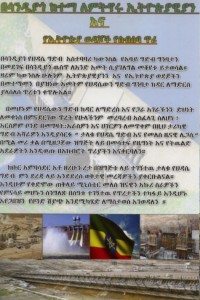 left
in City Heights Ethiopian markets and restaurants. One woman told me
that when the protesting group entered the cultural center they were met
with invectives, hostility and intimidation before being dispersed from
the meeting which had been publicized as open to the public.
left
in City Heights Ethiopian markets and restaurants. One woman told me
that when the protesting group entered the cultural center they were met
with invectives, hostility and intimidation before being dispersed from
the meeting which had been publicized as open to the public.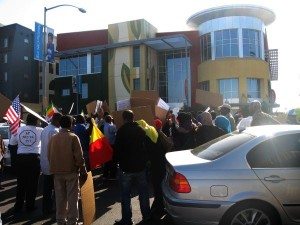 Because
the funding for the dam has not been fully secured, the government has
demanded that the populace pay directly for the needed bonds.
Protesters described the pressure brought to bear on businesses and
individuals to make “donations” for the bonds. Protesters that I spoke
with emphasized that dissenters are imprisoned under horrendous
conditions. “We have freedom here in this country, but our families
have no such freedom,” was repeated by men and women holding both the
American and Ethiopian flags.
Because
the funding for the dam has not been fully secured, the government has
demanded that the populace pay directly for the needed bonds.
Protesters described the pressure brought to bear on businesses and
individuals to make “donations” for the bonds. Protesters that I spoke
with emphasized that dissenters are imprisoned under horrendous
conditions. “We have freedom here in this country, but our families
have no such freedom,” was repeated by men and women holding both the
American and Ethiopian flags.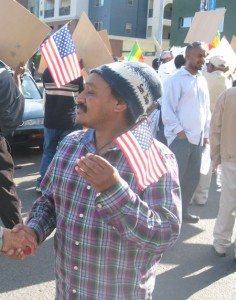 There were a few signs protesting the
There were a few signs protesting the 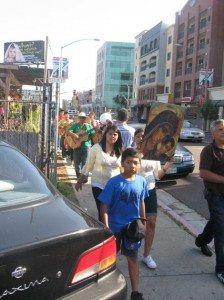 Human Rights Watch
Human Rights Watch